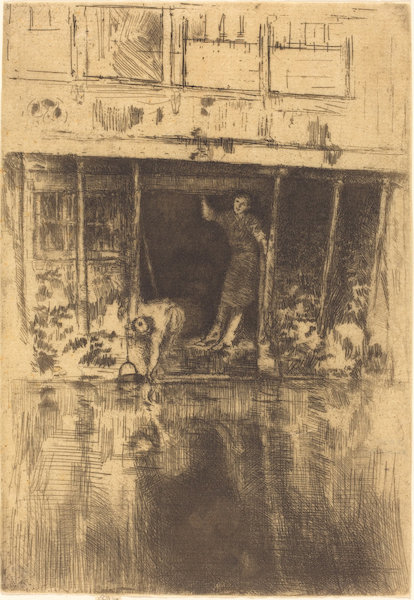Amsterdam Set
In 1889, Whistler and his new wife Trixie traveled to Amsterdam, the city of his artistic idol Rembrandt van Rijn, where he planned and executed the Amsterdam Set. He considered these etchings “the best work he had ever given to the public.”
The Amsterdam etchings represent the last stylistic phase of Whistler’s printmaking career. He applied lessons learned representing stonework in the Thames Set and architectural detail from the Venice Set to create a new technique. With etchings like Nocturne: Dance House, he created the effect of darkness not with the application of ink, as he had done with the Venice Set Nocturnes, but by building up lines on the surface of the plate. For The Embroidered Curtain, the best known of the Amsterdam etchings, Whistler used cross-hatching, parallel, vertical and horizontal lines made lighter or darker with his needle to distinguish brick from stone and glass from water. The water, the glass windows, the bricks and stones were woven together in patterns, like embroidery.
Click on image to advance the slides.
Whistler believed the Amsterdam Set to be the synthesis of the virtues of his style in the Thames Set and the compositional advances of the Venice sets.
Whistler’s Etchings: Recurring Themes from Karen Thomas on Vimeo.
In an article of March 11, 1890, in the Pall Mall Budget, he is recorded as having summed up his etching career in this way:
“I divide myself into three periods,” he says, being in his most serious and sensible mood. “First you see me at work on the Thames,” producing one of the famous series. “Now, there you have the crude and hard detail of the beginner. So far, so good. There, you see, all is sacrificed to exactitude of outline. Presently, and almost unconsciously, I begin to criticize myself, and to feel the craving of the artist for form and colour. The result was the second stage, which my enemies call The Inchoate, and I call Impressionism. The third stage I have shown you. In that I have endeavoured to combine stages one and two. You have the elaboration of the first stage and the quality of the second.”[1]
[1] Anonymous author, “A Chat with Mr Whistler,” Pall Mall Budget, March 13, 1890 as reproduced in Spencer, Whistler pp. 269—70.





